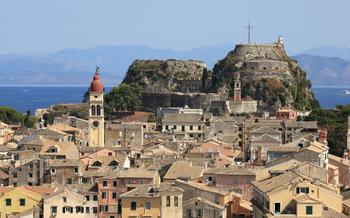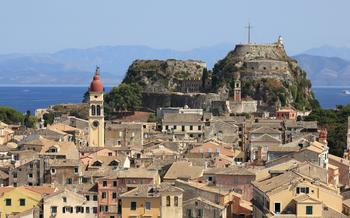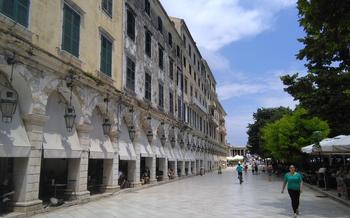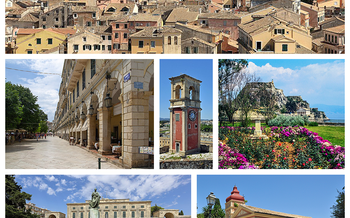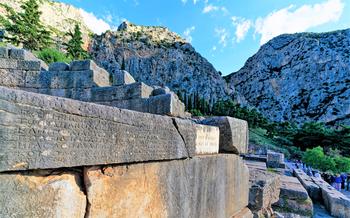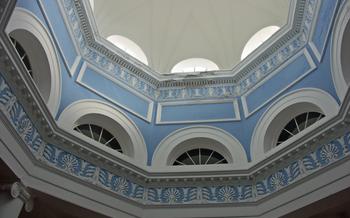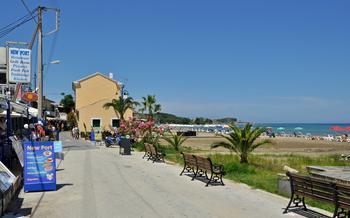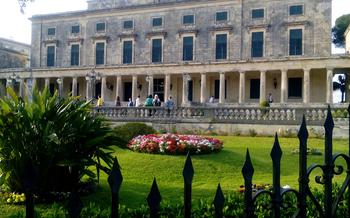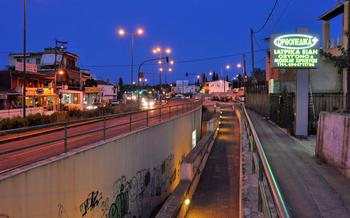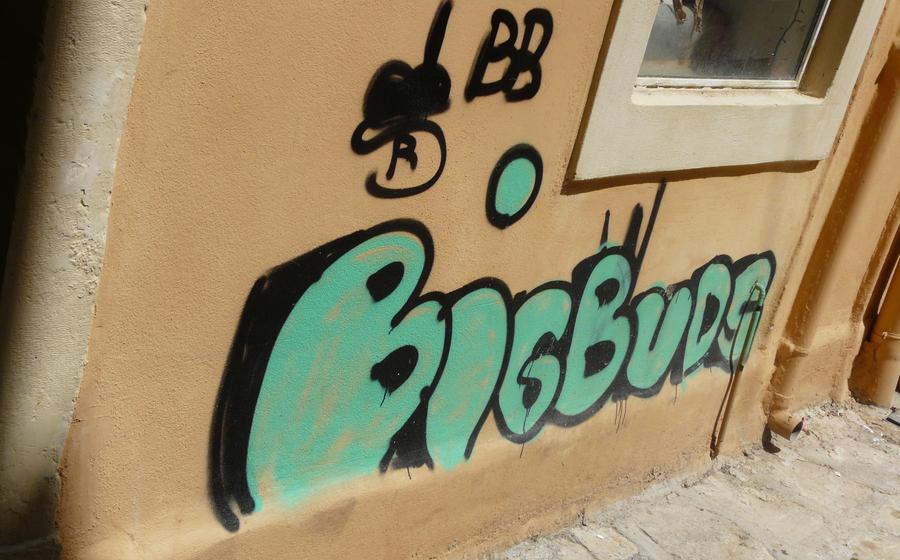
Archeological Site of Paleopolis
- The Antiquity of Corfu
- Unveiling the Ruins of Paleopolis: A Journey through Ancient Corfu
- Exploring the Ancient City
- The Temple of Artemis
- The Agora - The Heart of Paleopolis
- The Necropolis - A Glimpse into the Afterlife
- The Mon Repos Palace - A Royal Retreat
- The Museum of Asian Art - A Cultural Gem
- The Old Town of Corfu - A UNESCO World Heritage Site
- The Venetian Fortress - A Symbol of Strength
- The Liston - An Elegant Promenade
- The Corfu Cathedral - A Majestic Landmark
- Insider Tip: Discover the Hidden Gems
The Antiquity of Corfu
Corfu, a jewel of the Ionian Sea, holds a significant place in the annals of ancient Greece. Throughout history, its strategic location at the crossroads of the Mediterranean has made it a coveted prize, influencing its rich cultural heritage. In ancient times, Corfu, known as Korkyra, was a maritime power and a vital player in trade and commerce. Archaeological discoveries, including the impressive remains of Paleopolis, the ancient capital, provide a glimpse into the island's glorious past, showcasing its architectural prowess, cultural achievements, and the enduring legacy of its ancient inhabitants.
The island's strategic position made it a natural hub for trade and maritime activities, connecting the East and the West. Corfu's role as a trading center brought prosperity and cultural exchange, as ships from across the Mediterranean docked in its harbors, bringing goods, ideas, and influences from distant lands.
Archaeological excavations have unearthed a wealth of artifacts that attest to Corfu's vibrant ancient past, including pottery, coins, sculptures, and inscriptions. These discoveries shed light on the island's cultural and artistic traditions, providing valuable insights into the daily lives, beliefs, and practices of the ancient Corfiots.
Corfu's rich cultural heritage is a testament to the enduring legacy of its ancient past. The island's monuments, artifacts, and traditions are carefully preserved and celebrated, ensuring that the spirit of antiquity remains alive and vibrant, weaving a tapestry of history and culture that continues to captivate visitors to this day.
Unveiling the Ruins of Paleopolis: A Journey through Ancient Corfu
In the heart of Corfu, history whispers through the ruins of Paleopolis, inviting travelers to uncover the secrets of the island's ancient past. Located just a short distance from the modern capital, this archaeological site offers a glimpse into the origins of Corfu as the thriving ancient city-state of Korkyra.
Paleopolis, meaning "old city" in Greek, was founded by the Corinthians in the 8th century BC. Strategically positioned on a hill overlooking the sea, the city quickly rose to prominence as a maritime power, controlling trade routes and establishing colonies throughout the Mediterranean.
The excavation of Paleopolis began in the 19th century, revealing the remains of an impressive city that once rivaled the great centers of ancient Greece. As archaeologists carefully unearthed the layers of history, they discovered fortifications, temples, public buildings, and residential areas, providing a fascinating glimpse into the lives of the ancient Corfiots.
The city's fortifications, with their massive walls and towers, stand as a testament to the strategic importance of Paleopolis. Within the walls, visitors can explore the ruins of temples dedicated to Greek deities, including the Temple of Artemis, the patron goddess of the city.
Exploring the Ancient City
The ancient city of Paleopolis was a vibrant and bustling center, protected by massive city walls and fortifications that showcased the advanced engineering skills of its builders. These walls, some of which still stand today, formed a formidable barrier against potential invaders, ensuring the safety and security of the city's inhabitants.
Within the city walls, visitors can explore the remains of temples, public buildings, and residential areas that provide a glimpse into the daily life of the ancient Corfiots. The ruins of the Temple of Apollo, once a prominent religious center, stand as a testament to the city's devotion to the Olympian gods. The agora, the bustling marketplace and gathering place, reveals the economic and social activities that took place in the heart of Paleopolis.
Excavations at the site have unearthed a wealth of artifacts, pottery, and inscriptions that shed light on the diverse aspects of ancient Corfiot culture. These discoveries range from household items and tools to religious offerings and decorative objects, providing valuable insights into the artistic, economic, and religious practices of the city's inhabitants. Ongoing archaeological research and excavations continue to uncover new treasures, enriching our understanding of Paleopolis and its place in ancient Greek history.
The Temple of Artemis
A Sacred Sanctuary Dedicated to the Goddess of the Hunt
Among the many ruins and structures that make up the archaeological site of Paleopolis, the Temple of Artemis stands as a testament to the religious beliefs and practices of the ancient Corfiots. Dedicated to the goddess Artemis, the protector of wild animals and the hunt, this temple held a significant place in the religious life of the city.
The Temple of Artemis was constructed in the 6th century BC, during a period of great prosperity and cultural flourishing on Corfu. The temple's design and architecture reflect the influence of mainland Greece, with its Doric columns and pediments. The temple's facade was adorned with intricate carvings and sculptures depicting scenes from Greek mythology, adding to its grandeur and sacredness.
Inside the temple, archaeologists have discovered a wealth of votive offerings and religious artifacts, providing valuable insights into the rituals and practices that took place within its walls. These offerings included statuettes, pottery, and jewelry, all dedicated to the goddess Artemis in hopes of her favor and protection.
The discovery of the Temple of Artemis has shed light on the religious beliefs and practices of the ancient Corfiots, showcasing the importance of religion in their daily lives. The temple's ruins stand as a reminder of the enduring legacy of Greek mythology and the deep connection between humans and the divine in ancient times.
The Agora - The Heart of Paleopolis
At the heart of Paleopolis, the ancient agora served as the bustling marketplace and gathering place for the Corfiots. As you step into the agora, you can almost imagine the lively atmosphere of merchants haggling over prices, shoppers browsing for goods, and citizens engaging in lively discussions. The remains of shops and colonnades line the agora, providing a glimpse into the commercial activities that took place here.
Among the ruins, you'll notice the foundations of public buildings, suggesting the agora's role as a center of civic life. The discovery of coins, weights, and measures within the agora sheds light on the economic activities that flourished in this ancient marketplace. The agora was not merely a place of commerce but also a social and political hub, where citizens gathered to exchange news, make decisions, and participate in the democratic processes of their city-state.
The Necropolis - A Glimpse into the Afterlife
Just outside the city walls of Paleopolis lies the ancient necropolis, a poignant reminder of the final resting place of the ancient Corfiots. This burial ground offers a fascinating glimpse into their beliefs about the afterlife and provides valuable insights into the social structure and customs of the time.
The necropolis consists of a variety of tombs, ranging from simple pits to elaborate chamber tombs. Some tombs were reserved for individuals, while others were used for family burials. The discovery of grave goods and funerary objects, such as pottery, jewelry, and coins, sheds light on the beliefs and practices associated with death and the afterlife.
Through the study of these burials, archaeologists have gained a deeper understanding of the social hierarchy and customs of ancient Corfu. The size and elaborateness of a tomb often reflected the status and wealth of the deceased. The presence of grave goods suggests that the ancient Corfiots believed in providing the deceased with items they would need in the afterlife.
Exploring the necropolis is a moving experience that allows visitors to connect with the past and gain a deeper appreciation for the rich cultural heritage of Corfu. It is a reminder that even in death, the ancient Corfiots were not forgotten, and their legacy continues to live on.
The Mon Repos Palace - A Royal Retreat
Nestled amidst lush gardens on the outskirts of Corfu Town, the Mon Repos Palace stands as a testament to the island's rich history and royal connections. Built on the site of an ancient villa, the palace traces its origins to the 19th century when it served as the summer residence for the British Lord High Commissioner of the Ionian Islands. In 1864, the palace was acquired by the Greek royal family and became a beloved retreat for generations of Greek monarchs.
The Mon Repos Palace is a striking example of neoclassical architecture, seamlessly blending elements of Greek and Venetian design. Its elegant facade, adorned with intricate carvings and decorative moldings, exudes an air of grandeur and sophistication. The interior of the palace is equally impressive, boasting spacious rooms, high ceilings, and exquisite furnishings that reflect the refined taste and lifestyle of its royal occupants.
Beyond its architectural significance, the Mon Repos Palace holds a special place in the hearts of Corfiots. It was here that Prince Philip, the Duke of Edinburgh, was born in 1921, a fact that further cements the palace's connection to British royalty. Today, the palace serves as a museum, offering visitors a glimpse into the lives of the Greek royal family and the history of Corfu during the British protectorate.
The surrounding gardens, sprawling over 25 acres, are a delight to explore. Designed in the style of an English landscape garden, the grounds feature a variety of exotic plants, winding paths, and tranquil ponds. Visitors can stroll through the gardens, admiring the vibrant colors and fragrant blooms, and soak in the serenity of this beautiful natural setting.
Whether you're a history buff, a royal enthusiast, or simply seeking a tranquil retreat, the Mon Repos Palace is a must-visit destination in Corfu. Its architectural splendor, historical significance, and beautiful gardens make it a place of enchantment and wonder, capturing the essence of Corfu's rich heritage and royal legacy.
The Museum of Asian Art - A Cultural Gem
Housed within the elegant halls of the Mon Repos Palace, the Museum of Asian Art stands as a testament to Corfu's rich cultural heritage and its historical connections with the East. The museum boasts a captivating collection of artifacts from across Asia, spanning diverse cultures and civilizations.
Visitors can embark on a journey through the centuries, exploring the intricate porcelains and jade carvings from China, the delicate paintings and sculptures from Japan, the vibrant textiles and bronzes from India, and the exotic masks and musical instruments from Southeast Asia. Each artifact tells a story of cultural exchange, artistic expression, and the interconnectedness of the ancient world.
The museum's collection was meticulously assembled over many years, thanks to the contributions of passionate collectors and the patronage of the Greek royal family. Today, it stands as a treasure trove of Asian art, offering visitors a unique glimpse into the diverse artistic traditions and cultural heritage of the East.
Whether you're an art enthusiast, a history buff, or simply curious about the world's diverse cultures, the Museum of Asian Art is a must-visit destination in Corfu. Prepare to be captivated by the exquisite craftsmanship, the vibrant colors, and the intricate symbolism that define each piece in this remarkable collection.
The Old Town of Corfu - A UNESCO World Heritage Site
The Old Town of Corfu, the historic heart of the island, is a captivating fusion of architectural styles and cultural influences, a testament to its rich and diverse past. Wander through its labyrinthine streets, lined with Venetian mansions, charming boutiques, and traditional tavernas, and immerse yourself in its vibrant atmosphere. The narrow alleys lead to hidden squares, each with its own unique character, adorned with Venetian wells, ornate churches, and pastel-colored buildings.
The Old Town's UNESCO World Heritage designation is a testament to its outstanding cultural and historical value. This recognition highlights the town's significance as a living museum, showcasing the harmonious blend of Venetian, Byzantine, and French architectural elements. The narrow streets, known as "kantounia," create a maze-like layout, adding to the Old Town's charm and mystery.
Among the must-see attractions in the Old Town are the Old Fortress, a formidable Venetian citadel guarding the harbor's entrance, the Liston, an elegant promenade lined with cafes and shops, and the Corfu Cathedral, a majestic Byzantine-inspired church. These landmarks, along with the numerous museums, galleries, and historical sites, offer a glimpse into Corfu's rich past and vibrant cultural heritage.
Whether you're strolling along the picturesque streets, savoring local delicacies in traditional tavernas, or exploring the hidden gems tucked away in every corner, the Old Town of Corfu promises an unforgettable experience, transporting you back in time to a world of history, culture, and authentic charm.
The Venetian Fortress - A Symbol of Strength
The Venetian Fortress, an imposing monument to Corfu's rich history, stands proudly on the island's eastern coast, guarding the entrance to the Old Town. Constructed in the 16th century by the Venetian Republic to protect Corfu from invading forces, this formidable fortress played a crucial role in safeguarding the island from numerous attacks.
Its strategic location, commanding views of the sea and the surrounding landscape, made it an impenetrable stronghold. The fortress's impressive fortifications, featuring thick walls, ramparts, and bastions, showcased the Venetians' mastery of military engineering.
Within the fortress, visitors can explore a network of tunnels, chambers, and courtyards, providing a glimpse into the daily life of the soldiers who once manned its defenses. The fortress's well-preserved state allows visitors to imagine the fierce battles that took place within its walls, as Corfu successfully repelled attacks from the Ottomans and other adversaries.
Today, the Venetian Fortress stands as a symbol of Corfu's resilience and enduring legacy. Restored and transformed into a cultural and historical venue, it hosts various events, exhibitions, and performances, inviting visitors to delve into the island's captivating past.
The Liston - An Elegant Promenade
The Liston, a captivating promenade located in the heart of Corfu's Old Town, holds a special place in the island's history and culture. Once a fashionable gathering spot for the Venetian aristocracy, the Liston exudes an air of elegance and sophistication with its distinctive arcades, upscale cafes, and boutique shops.
As you stroll along the Liston, admire the graceful architectural features that blend Venetian and French influences. The arcaded walkways provide shade and shelter from the sun or rain, creating a pleasant ambiance for leisurely walks or people-watching.
In the evenings, the Liston transforms into a vibrant social hub, where locals and visitors alike gather to enjoy a leisurely coffee, sip on a refreshing cocktail, or indulge in delicious local cuisine at one of the many restaurants and cafes that line the promenade.
The Liston's cultural and social significance extends beyond its architectural beauty. It has served as a meeting point for intellectuals, artists, and prominent figures throughout history, fostering a lively exchange of ideas and cultural influences.
Today, the Liston remains a beloved landmark and a symbol of Corfu's cosmopolitan past. Whether you're seeking a stylish shopping experience, a delightful culinary adventure, or simply a place to relax and soak up the atmosphere, the Liston offers a captivating blend of history, culture, and contemporary charm.
The Corfu Cathedral - A Majestic Landmark
Amidst the vibrant streets of Corfu Town stands the Corfu Cathedral, a majestic edifice that embodies the island's rich history and deep-rooted faith. Dedicated to the Virgin Mary, the cathedral is not only a sacred place of worship but also a captivating architectural masterpiece that draws visitors from far and wide.
Constructed in the 16th century, the Corfu Cathedral seamlessly blends Byzantine and Venetian influences, reflecting the island's diverse cultural heritage. Its imposing façade, adorned with intricate carvings and sculptures, hints at the grandeur that awaits within. Step inside, and you'll be awestruck by the soaring arches, ornate decorations, and gleaming chandeliers that illuminate the vast interior.
The cathedral's most striking feature is its stunning iconostasis, a partition adorned with a breathtaking array of icons depicting biblical scenes and saints. Each icon is a work of art, crafted with meticulous attention to detail and vibrant colors that captivate the eye. The iconostasis serves as a symbolic gateway between the earthly realm and the divine, inviting visitors to contemplate the sacred mysteries of the faith.
Beyond its artistic beauty, the Corfu Cathedral holds immense religious and cultural significance for the people of Corfu. It is a place where generations have gathered for worship, celebration, and solace. The cathedral has witnessed countless baptisms, weddings, and funerals, serving as a backdrop for the most important moments in the lives of Corfiots.
As you explore the cathedral, take a moment to reflect on its enduring legacy. Imagine the countless prayers that have been whispered within these walls, the joyous hymns that have filled the air, and the profound spiritual experiences that have taken place here. The Corfu Cathedral is more than just a building; it is a living testament to the enduring power of faith and the resilience of the human spirit.
Insider Tip: Discover the Hidden Gems
Beyond the popular tourist attractions, Corfu holds a treasure trove of hidden gems waiting to be explored. Venture off the beaten path and discover the island's lesser-known charms. Explore the traditional villages nestled amidst olive groves, where time seems to stand still. Relax on secluded beaches, far from the crowds, and immerse yourself in the tranquility of nature. Lace up your hiking boots and embark on scenic trails that lead you through lush forests and breathtaking landscapes.
Seek out local tavernas and restaurants, tucked away in narrow cobblestone streets, to savor authentic Corfiot cuisine and experience the warmth of Greek hospitality. Indulge in fresh seafood, homemade dishes, and local wines while enjoying the lively atmosphere of these traditional eateries.
Take advantage of boat trips and excursions to explore the nearby islands and hidden coves that dot the Ionian Sea. Discover secluded beaches, swim in crystal-clear waters, and explore the underwater world by snorkeling or diving.
Embrace the slow pace of life and immerse yourself in the unique culture and traditions of Corfu. Engage with the friendly locals, learn about their customs, and participate in local festivals and events. Whether you're seeking adventure, relaxation, or cultural exploration, Corfu has something to offer beyond its well-known attractions.
